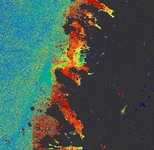IntroductionThis page shall briefly describe the influence of the wrong resampling of the view azimuth angles in Sentinel-2 data. It shall show the need for a specific Sentinel-2 resampling methodology. The investigation was done initially in the context of the validation of C2RCC processing results. In the chlorophyll output of the C2RCC processor the influence of wrong angular interpolation during the resampling to a common resolution is clearly visible. This results from the coarse grid the angles are provided. By default the angles are resampled (up-sampled) using nearest neighbour method. This results in hard cuts and wrong angles for the pixels close to the CCD edges. |
Problem understanding
Sentinel 2 has 12 individual detectors for the VISNIR bands, aligned in two rows, and additional detectors for the SWIR bands on a different focal plane. Due to the high spatial resolution, a certain point on earth is viewed by different detectors at different times, and thus the viewing geometry for the individual bands within the spectrum differs. Consequently, the viewing angles are provided per band in the S2 image file. This means, a spectrum measured by S2 has different view angles per band. This cannot be handled by any processor we are aware of. Further more, the information, which pixel on which CCD measured a certain image pixel, is not available in the L1C product. This would be required to get the image geometry fully correct. As a consequence, Marco and Carsen concluded that it is impossible to work with the precise angles. An approximation has to be used in any case. We now believe that it will not be possible for C-S to provide a perfect reader that gets the exact angles per pixel. And even if so, the C2RCC could not work with per-band-angles. So, we have to find the approximation with the lowest error.
...
As long as it's not possible to have the view azimuth angle per pixel (if ever) the best solution is to use a bi-linear interpolation for all angles. For the the radiometry bands it would be best to use the mean resampling for the down-sampling. When the radiometry bands need to be up-sampled the same resampling algorithm (bi-linear) as for the angle bands is applied at the moment. Radiometrically the best up-sampling method would be nearest neighbour.
...
